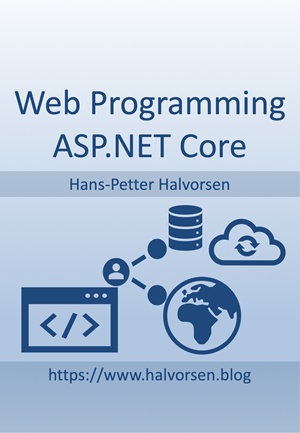1 Introduction
In this C# project you will use Industrial DAQ Systems and Sensors, you will use Database Systems, perform Datalogging, create modern Web Applications, and taking care of Cyber Security issues when it comes to modern industrial applications.
Introduction to C# Project (YouTube) + PowerPoint (PDF)
Microsoft Teams
Do you have questions working with the project? Use Microsoft Teams (Note! You need to click on the link to the left to request access to the Teams room). Here you can get help and guidance regarding the project. You can ask questions to the supervisors/instructors or ask questions to other students. You can also respond to questions from other students. You learn a lot from helping each other. If you help others, others may want to help you. Many students also typically have the same questions, so then the supervisor only needs to answer the question once, and you can easily see previous questions and answers in the chat/post in Teams. There are several supervisors involved in this project. By using Microsoft Teams instead of sending E-mail, you will reach everyone and the person (which can be a supervisor or a student) that can answer the question best or fastest will respond.
Below you see an overview of the project:
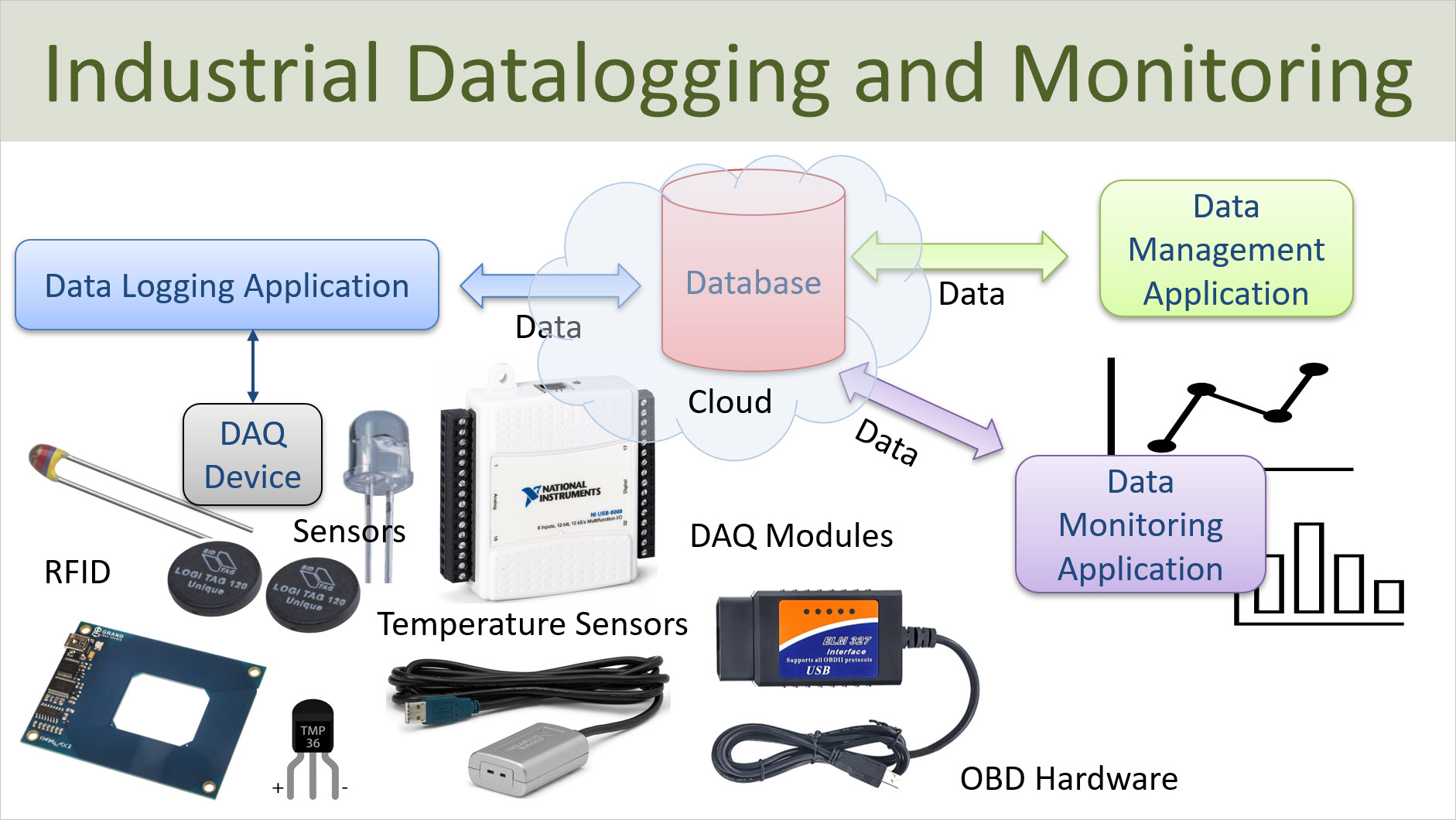
Additional Resources
Write Technical Reports in Microsoft Word (YouTube) - Here you learn the basic structure of a Technical Report, how to insert Figure Captions and refer to those in the text, how to insert Equations and refer to those in the text, how to add References, etc.
Project Checklist (PDF) - Use the checklist as guidelines or recommendations for what you shall make and how.
Report Checklist (PDF) - Use the checklist as guidelines or recommendations for the structure and contents of the report.
Report Template (MS Word) - This is just an examle, you may use another template or create and use your own personal template.
Equations and Figures in Microsoft Word and PowerPoint (YouTube) - Word and PowerPoint have a great Editor for writing Equations, Formulas and other Mathematical Expressions. Make sure to use it when writing equations, etc. in your report. PowerPoint is a great tool for making different types of sketches and figures (dont use MS Paint). Typically, these sketches may include some Mathematical Expressions. So here you can use the Formula Editor in PowerPoint.
Citation and Referencing with Microsoft Word (YouTube) - Make sure that you know how you refer to other sources in your report.
Visual Studio and C# - YouTube Playlist (YouTube) - Here you find videos if you need to fresh up Visual Studio and C# fundamentals.
C# Programming Project - YouTube Playlist (YouTube) - Here you find videos that can help you solve the different parts of the projects. Not all videos are relevant to your chosen project.
Typically, you should also include a System Sketch (here you see a video how to make a system sketch in PowerPoint in less than 5 minutes). A System sketch is an illustration/figure of your system, the different parts the system consists of, and how they relate to each other. PowerPoint is a great tool for making different types of sketches and figures in just a few minutes compared to more advanced tools.
2. Applications
In this project we will create 3 different C# Applications:
- Data Logging Application
- Data Management Application
- Data Monitoring Application
These Applications shall communicate with a SQL Server Database. The Data Logging Application should typically be an ordinary Desktop Application (Windows Forms App), while the Data Management Application can be either a Desktop Application (Windows Forms App) or a Web Application using ASP.NET Core (ASP.NET Core Web App). The Data Monitoring Application should preferably be a Web Application using ASP.NET Core (ASP.NET Core Web App), but you can create a DEsktop Application here as well.
Below you find some basic examples for these 3 applications. Note! the names refer to the functionality typically included in these applications. If you prefer and depending on your projects, you can use other names for the applications.
Data Logging Application
The Data Logging Application are responsible for collecting data from your devices and sensors. The Data Logging Application typically needs to be a Desktop Application because you need to connect som hardware (DAQ device, sensors, etc) on the client that communicates using serial communication, etc. See basic example below to get some ideas. You will also find more examples and resources in the other sections on this web page.
Examples:
Datalogging Application WinForm Example (YouTube) - This examples shows Datalogging using SQL Server with C#. Here you see the PowerPoint (PDF) used in the video. The example shown in the video can be improved by including a chart/plot, see this video: ScottPlot (YouTube).
Data Management Application
The Data Management Application is used to add, edit or delete data in the database based on interactions with the user. The Data Management Application can be a Desktop Application or a Web Application. See basic examples below to get some ideas.
Windows Forms Examples:
WinForm Example (YouTube)
Creating a Windows Forms CRUD Application (YouTube) - CRUD Application means Creating, Reading, Updating and Deleting Data in a Database from your Application. The CRUD application presented here can be a foundation for all your WinForms Applications. Typically, all Applications today need to communicate with a Database and has CRUD functionality. When you have learned to create a basic CRUD Application, you have all the necessary tools you need to create any kind of Application.
ASP.NET Core Examples:
ASP.NET Core Example - Basic (YouTube)
ASP.NET Core Example - Intermediate (YouTube)
Data Monitoring Application
The Data Monitoring Application is used to view and monitor data from the devices and the sensors used. The Data Monitoring Application should preferably be a Web Application. See basic examples below to get some ideas.
The built-in Chart Control for Windows Forms is no longer supported by Microsoft in the latest .NET versions. So, we may need to find and use alternative solutions. If you still want to use the built-in Chart Control for Windows Forms, you need to select the "Windows Forms App (.NET Framework)" Template. If you choose the newer "Windows Forms App" Template, the built-in Chart Control is no longer supported. In that case, you may use the ScottPlot Plotting Library which is explained in the Tutorial below.
Windows Forms Examples:
Plotting Data in Windows Forms using ScottPlot - ScottPlot is a free and open-source Plotting Library for .NET.
ASP.NET Core Examples:
ASP.NET Core Example - Chart (YouTube) - Here Google Charts has been used to present the data in a chart on the web page.
ASP.NET Core Example - Table (YouTube) - Here the data is just presented in a table on the web page.
3 Visual Studio/C#
Introduction to Visual Studio and C# (YouTube) + PowerPoint (PDF) - This Tutorial give an introduction to Visual Studio and C#.
Additional Resources:
Simulation and Control with C# and WinForms (YouTube) + PowerPoint (PDF) - This Tutorial goes through how to create a basic Windows Forms Application in Visual Studio/C#.
SQL Server with C# Windows Forms App (YouTube) + PowerPoint (PDF) - This Tutorial goes through how to create a basic Windows Forms Database Application in Visual Studio/C# that communicates with an SQL Server.
Visual Studio, C# and SQL Server - Creating a Windows Forms CRUD Application (YouTube) + PowerPoint (PDF) - This Tutorial goes through how to create a Windows Forms Application in Visual Studio with CRUD functionality. It will communicate with an SQL Server Database. It will Insert, Retrieve, Update and Delete Data using an SQL Server Database.
Create and use Multiple Forms in a Desktop Application (YouTube) + PowerPoint (PDF) - By creating a Windows Forms Application with only one Form you may end up with a very complicated and poor designed GUI. This Tutorial will show how you can create and use Multiple Forms in your WinForms Desktop Application. Then it is much easier to create a logical and structured GUI. It is not more complicated to create and use multiple Forms in your Application and the results becomes so much better! All professional applications use multiple windows.
Additional Resources:
C# Tutorial (w3schools.com) (Website) - Good resource for C# syntax
4 Hardware
We can choose between different hardware options, like TC-01, USB-6008, RFID and OBD.
DAQ (Data Acquisition) is typically needed in all types of applications, which is about getting data from the sensors. Data Acquisition (DAQ) is the process of collection data from different sensors into a computer. A DAQ System consists of 4 parts: Physical input/output signals, sensors DAQ device/hardware Driver software Your software application (Application software).
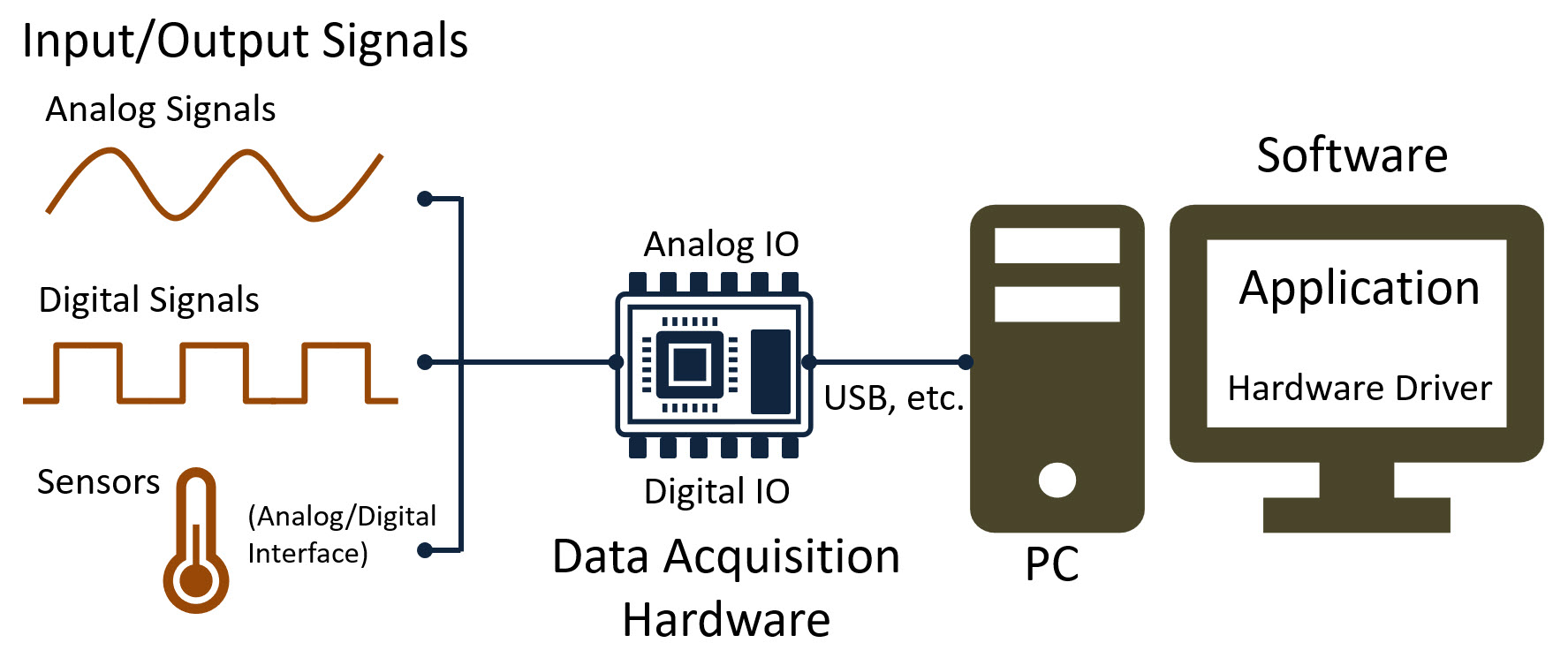
Visual Studio/C# and DAQ Tutorial - The purpose is to read and write data using a DAQ device where we use Visual Studio and C#. We will exemplify by using a DAQ device from NI (previously National Instruments).
Below you find an overview and resources for the different DAQ systems that you can select between in this project (you select only one of these).
Hardware DAQ systems:
4.1 TC-01 (System #1)
TC-01 from NI (National Instruments) can be used to read the Temperature from the surroundings. It uses the Thermocouple principle.

To use the TC-01 DAQ device from NI (National Instruments), you need to install the NI-DAQmx driver.
Firmware: If you get error using TC-01, you may need to upgrade the Firmware.
Here you find information about the TC-01 specifications. Here you find the TC-01 User Guide.
Temperature Sensor TC-01 in Visual Studio using DAQmx (YouTube) + PowerPoint (PDF)
Additional Resources:
Visual Studio/C# and DAQ Tutorial - The purpose is to read and write data using a DAQ device where we use Visual Studio and C#. We will exemplify by using a DAQ device from NI (previously National Instruments).
4.2 USB-6008 (System #2)
USB-6008 from NI (National Instruments) can be used to acquire data from different types of Sensors You can, e.g., make a Home Automation System where you have placed one or more such DAQ devices in different rooms in your home and you have different sensors attached to these DAQ devices USB-6008 has Analog and Digital Input and Output Channels.
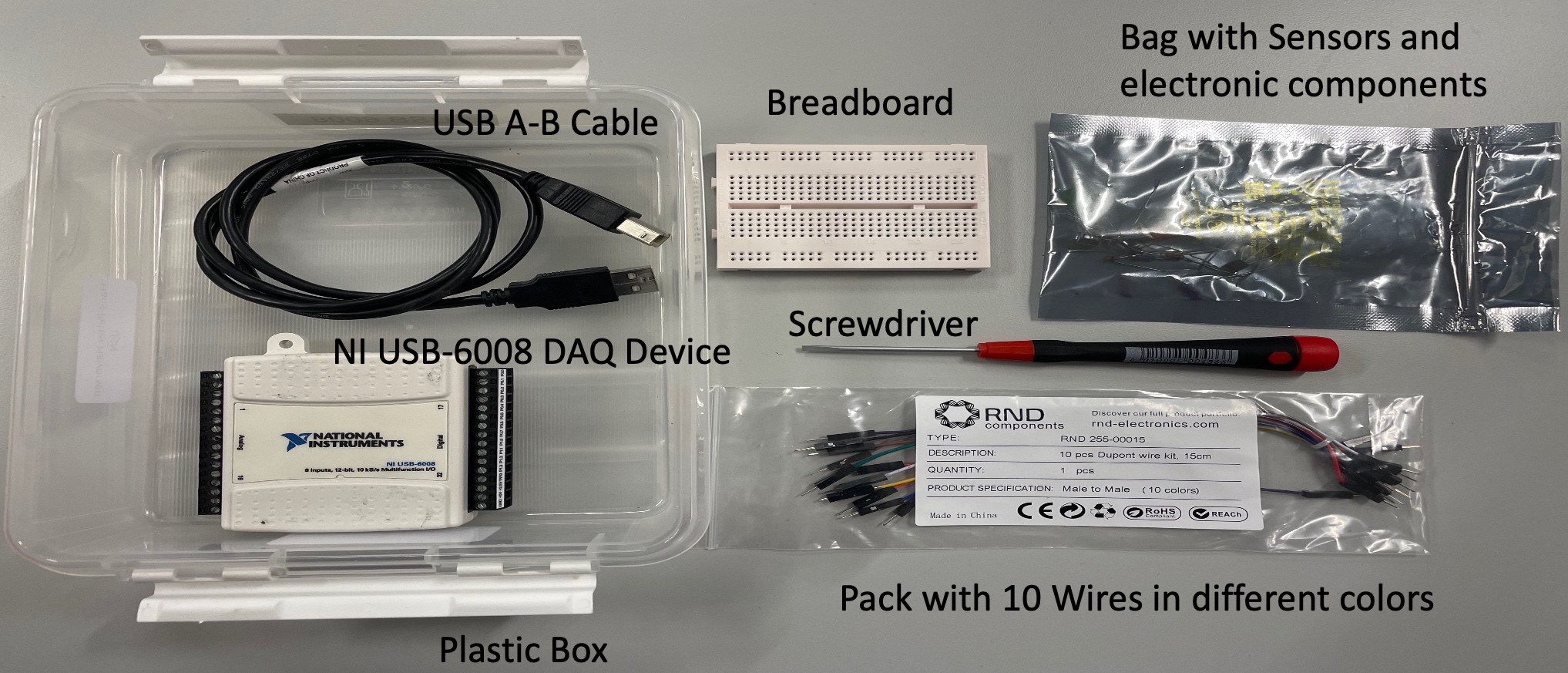
To use USB-6008 from NI (National Instruments), you need to install the NI-DAQmx driver.
Make sure to read the User Guide and Specifications for USB-6008 and USB-6008 Pinout.
Visual Studio/C# and DAQ Tutorial - The purpose is to read and write data using a DAQ device where we use Visual Studio and C#. We will exemplify by using a DAQ device from NI (previously National Instruments).
Additional Resources for different types of Sensors and components:
TMP36 Temperature Sensor (YouTube) + PowerPoint (PDF)
Thermistor Temperature Sensor (YouTube) + PowerPoint (PDF)
Light Sensor (YouTube) + PowerPoint (PDF)
LEDs (YouTube) + PowerPoint (PDF)
4.3. RFID (System #3)
RFID uses radio waves produced by a reader to detect the presence of (then read the data stored on) an RFID tag. Tags are embedded in small items like cards, etc. Typical applications are access control, item tracking, etc.
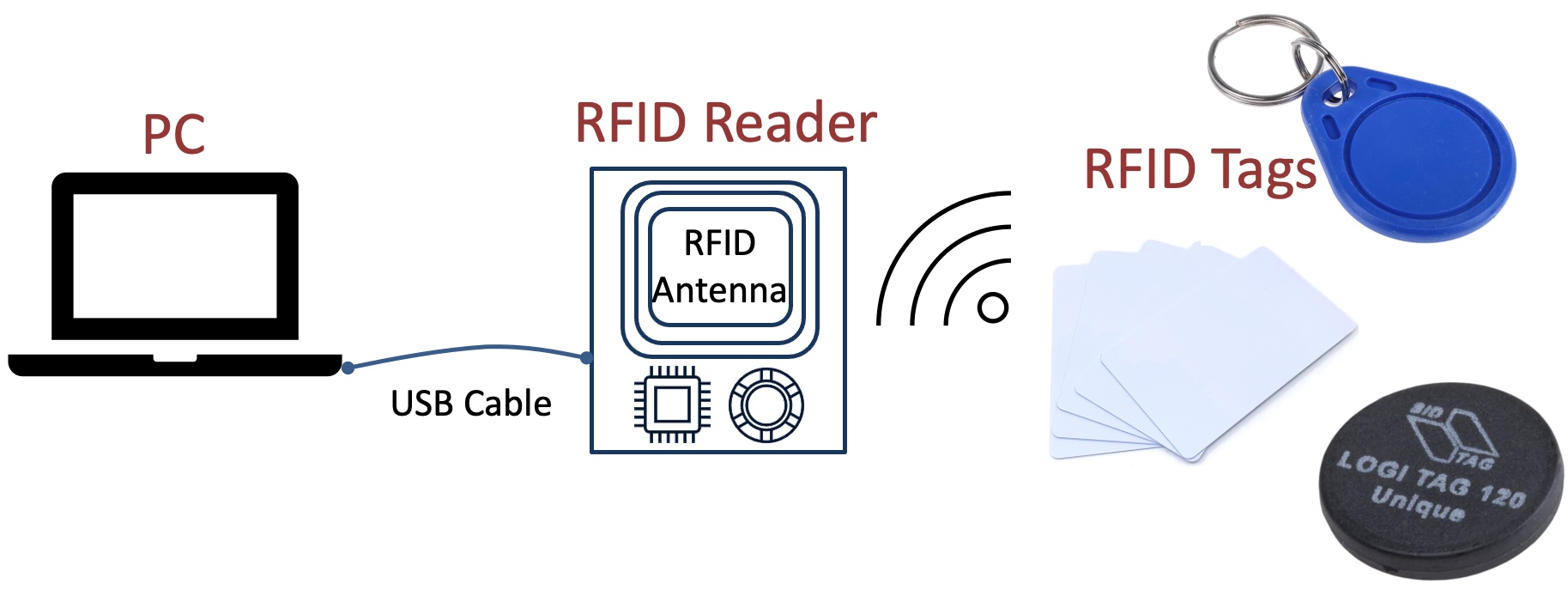
Resources:
RFID Basics (Website, Sparkfun)
RFID (YouTube) + PowerPoint (PDF) - General overview of RFID with some examples
Bachelor Project (PDF) + Final Report (PDF) - "Implementering av automatisk utlånssystem for verktøylager". Use it for inspiration when development of your own project.
You can choose between 2 different RFID systems, see details below.
- Desktop Reader NEO 2 HF RFID Reader (13.46Hz)
- Parallax 28340 RFID USB Reader System (125KHz)
RFID Alt 1: Desktop Reader NEO 2 HF RFID Reader (13.56MHz)
Below you see the Desktop Reader NEO 2 HF RFID Reader System. The system consists of a USB RFID reader with a built-in antenna inside a case bith built-in, USB A cable. Different RFID Tags are included.
Note! You can use your Student Card as an extra RFID Tag for this system.
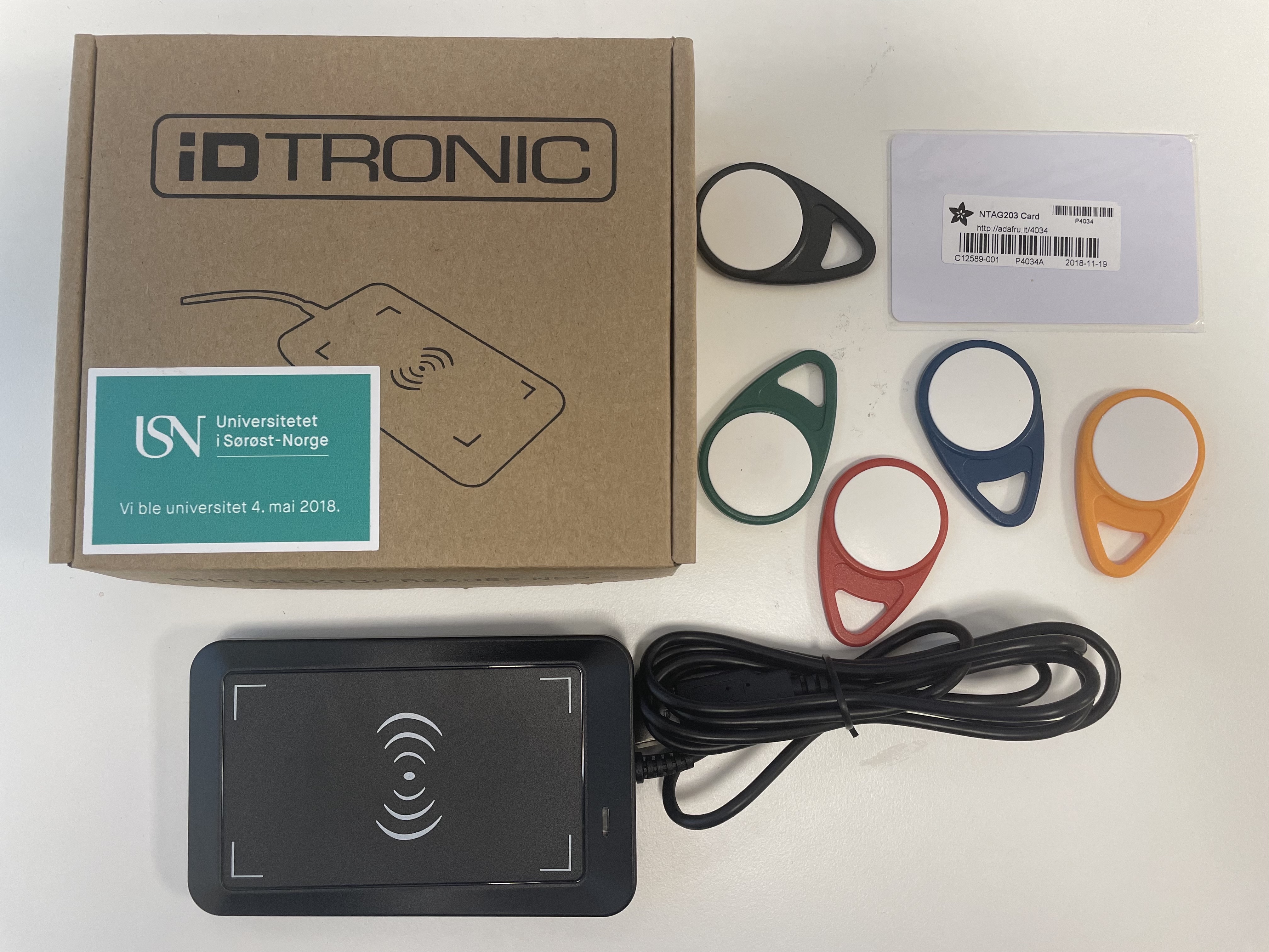
Note!! The RFID reader is normally ready to use from the factory in so-called HID Mode (which is recommended!!) So, you normally don’t need to do any configurations!!
Getting Started: The only thing you need to do is connect the RFID reader to the PC using the USB cable. For testing, you can open MS Word. Then place an RFID tag on the reader, and the tagid will automatically be scanned and be displayed in MS Word. The same is done in Visual Studio and C#. Create a new application, insert a Textbox, start the application. The tagid will then be automatically put into the Textbox. You are now ready to start creating your application.
Visual Studio/C# Examples:
RFID Reader with Windows Forms Examples (YouTube) + PowerPoint (PDF)
Typically, you need to create a Desktop Application (and not a Web Application) in order to communicate with such a device. But since this device (Desktop Reader NEO 2) does not need any C# code (which is executed server-side in a web application) to work, you can also use it in ASP.NET Core, since it only needs an active TextBox to work.
ASP.NET Core RFID Web Application (YouTube) + PowerPoint (PDF)
Additional Resources:
Desktop Reader NEO 2 HF RFID Reader (13.56MHz) (YouTube) + PowerPoint (PDF)
Desktop Reader NEO 2 HF 13.56Hz (Website, iDTRONIC) - Make sure to read the Datasheet, etc.
RFID Alt 2: Parallax 28340 RFID USB Reader System (125KHz)
Below you see the Parallax 28340 RFID USB Reader System. The system consists of a USB RFID reader with a built-in antenna, A USB-A to Mini-B cable and different RFID Tags.
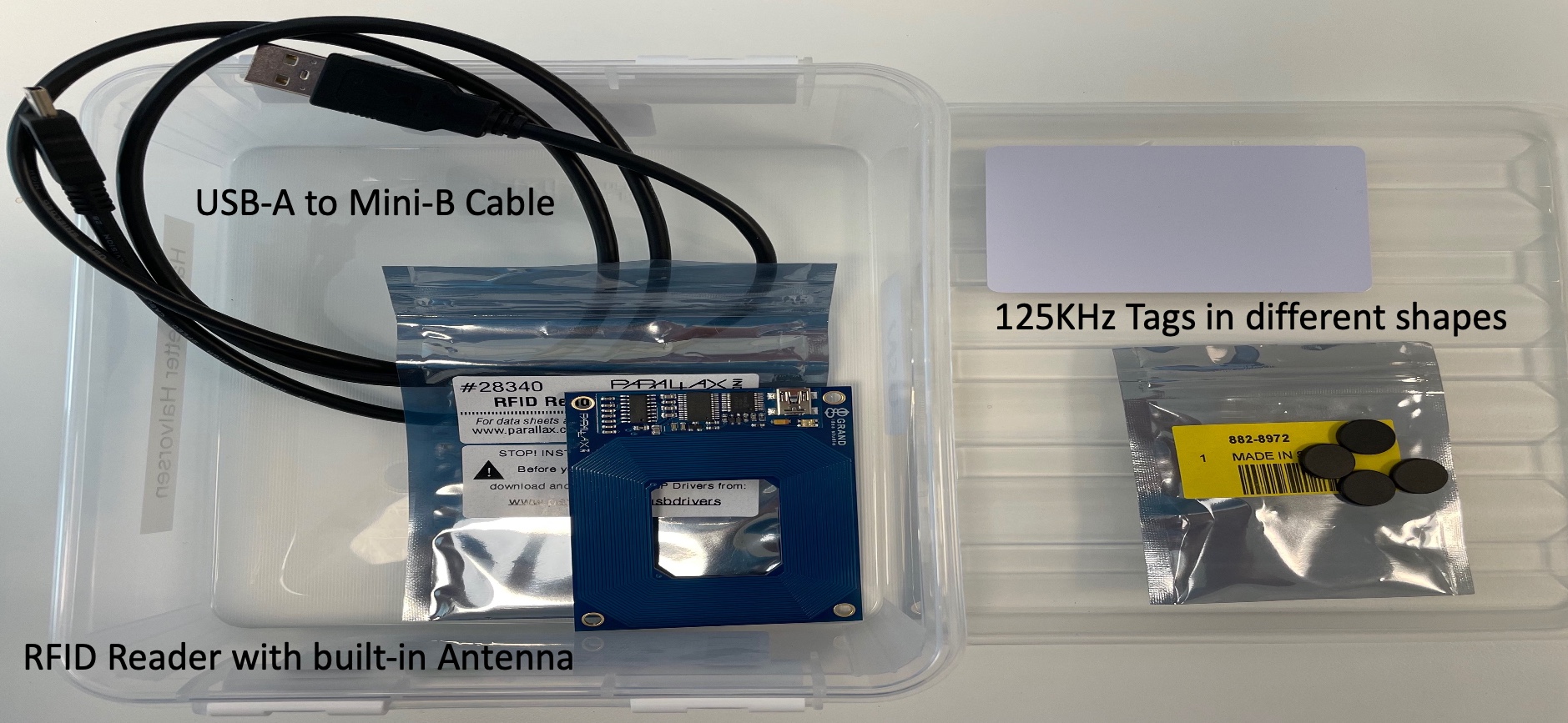
Parallax 28340 RFID USB Reader System (125KHz) (YouTube) + PowerPoint (PDF)
Resources:
Parallax 28340 RFID USB Reader (Website, Parallax) - Make sure to read the Datasheet, etc.
Parallax FTDI USB Drivers for Windows (Website, Parallax) - Make sure to install the driver BEFORE you plug in your Hardware!
4.4 OBD (System #4)
On-board diagnostics (OBD) is an automotive term referring to a vehicle's self-diagnostic and reporting capability. OBD systems give the vehicle owner or repair technician access to the status of the various vehicle sub-systems. OBD implementations use a standardized digital communications port to provide real-time data. A standardized series of diagnostic trouble codes, or DTCs, are also provided. OBD-II is the latest standard used today. An OBDII Interface ELM327 with USB will be used in this project. Read more (Wikipedia).
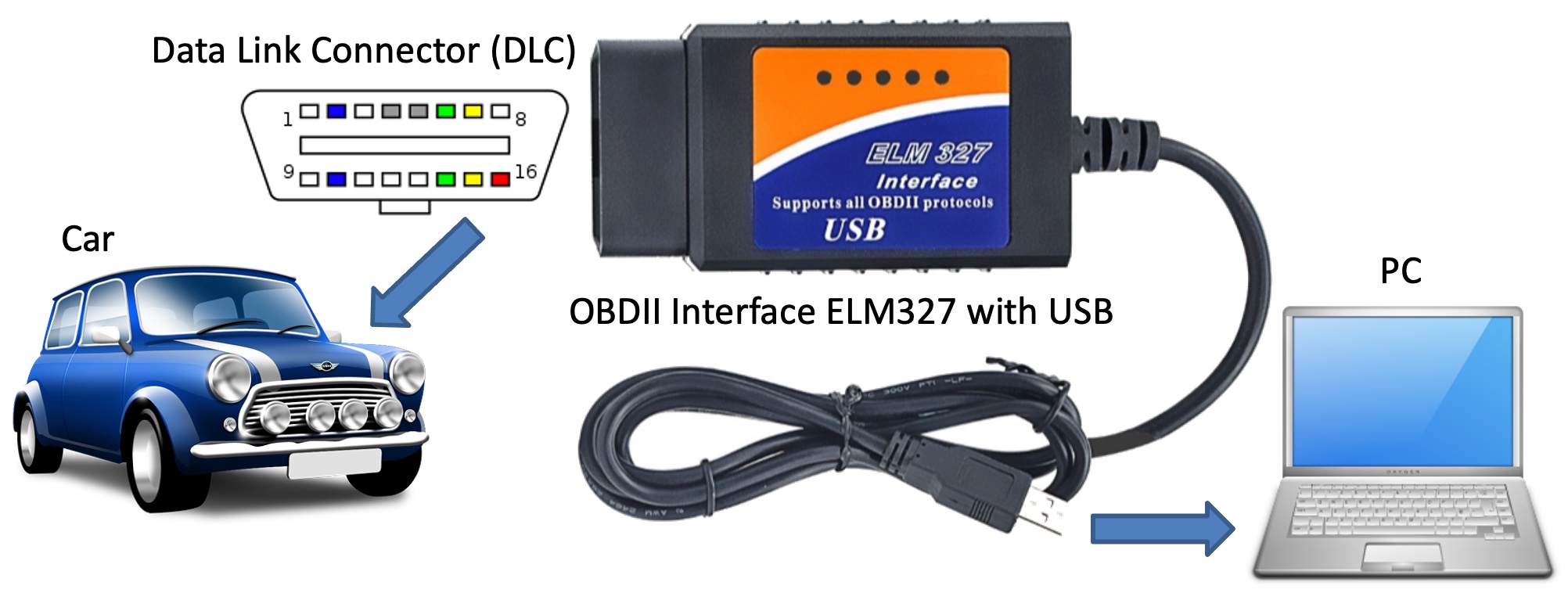
OBD Resources:
Getting Started with OBD-II (Website, Sparkfun)
USB OBDII Car Dignostic Scanner - User Guide (PDF)
www.elm327.com (Website) - Here you find lots of OBD resources, including the necessary Hardware Driver (PL2303 USB OBDII Driver).
The software ScanMaster-ELM is also recommended, which is an OBD-2/EOBD diagnostic scan tool for vehicle diagnostics under OBD-II/EOBD standards that were developed specifically for the ELM327.
Data Communication Resources:
Introduction to Data Communication with C# Programming (Textbook, PDF)
C# Programming Data Communication (PowerPoint ,PDF)
OBD Example Data File - Can be used to get OBD Test data into your system when developing and testing your system.
5 SQL Server
A Database is a structured way to store lots of information. The information is stored in different tables.
Resources:
Introduction to Database Systems (YouTube)
erwin Data Modeler - Academic Edition (YouTube) + PowerPoint (PDF). Her you can Download erwin Data Modeler Academic Edition
SQL Server Express Installation (YouTube)
SQL Server and Structured Query Language (SQL) (YouTube) + PowerPoint (PDF)
Database Views and Stored Procedures (YouTube) + PowerPoint (PDF)
SQL Server with C# Windows Forms App (YouTube) + PowerPoint (PDF) - This Tutorial goes through how to create a basic Windows Forms Database Application in Visual Studio/C# that communicates with an SQL Server.
Datalogging using SQL Server with C# (YouTube) + PowerPoint (PDF) - This Tutorial goes through how to create a basic Datalogging Windows Forms Application in Visual Studio/C# that Save Data inside a SQL Server Database.
Datalogging and Monitoring (YouTube) - This Tutorial gives an example of a basic Datalogging and Monitoring System.
Additional Resources:
6 Web Programming
To create a typical web page you need to combine 3 languages:
- HTML - The language for building web pages
- CSS - The language for styling web pages
- JavaScript - The language for programming web pages
Use HTML to define the content of web pages, CSS is used to specify the layout of web pages, while JavaScript is used to program the behavior of web pages. For creating more dynamic web pages, we typically also use a web framework like PHP or ASP.NET, etc. With these frameworks you can communicate with a database for storing or retrieving data.
Below we se the triangle used in most web pages, namely HTML, CSS and JavaScript.
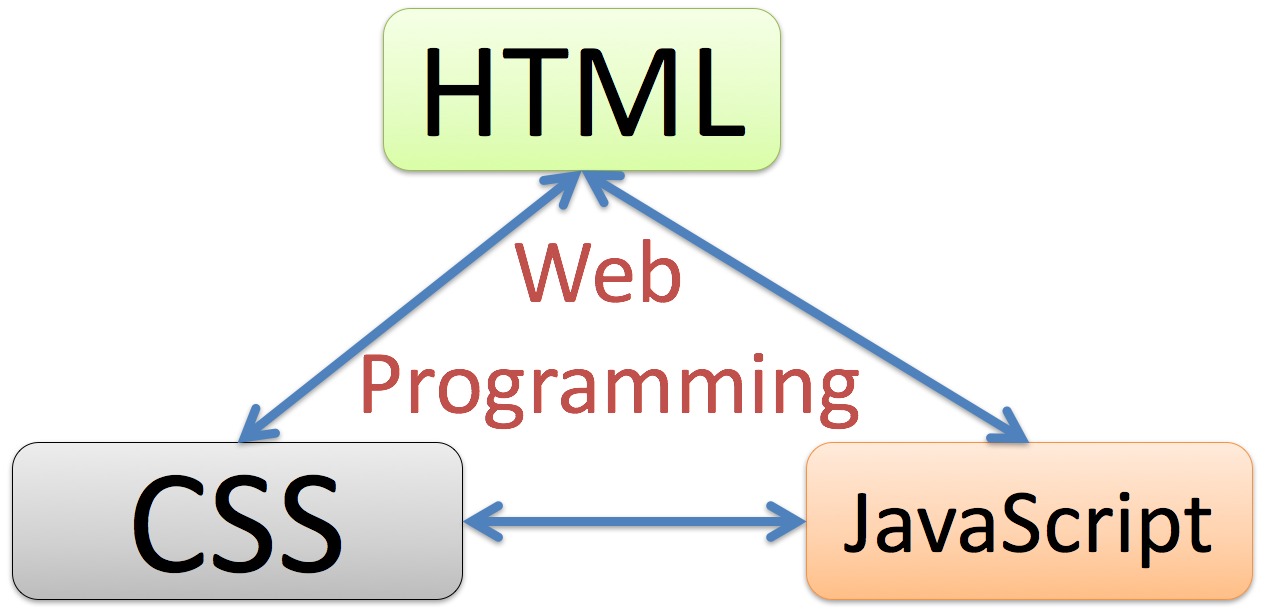
Resources:
Web Programming Overview (YouTube) + PowerPoint (PDF)
Create Web Pages with HTML and CSS (YouTube) + PowerPoint (PDF)
Additional Resources:
7 ASP.NET Core
ASP.NET is an open source web framework, created by Microsoft, for building web apps and services using the .NET Framework or the .NET Core. We have both ASP.NET and ASP.NET Core. ASP.NET Core is the new approach built on .NET Core.
Web Programming ASP.NET Core (Textbook, PDF)
Resources
Introduction:
ASP.NET Core - Hello World Application (YouTube)
ASP.NET Core - Introduction (YouTube) + PowerPoint (PDF)
Database Communication in ASP.NET Core:
ASP.NET Core - Get Data from Database (YouTube) + PowerPoint (PDF) - Here you learn the basics when it comes to how to get/retrieve data from a SQL Server database.
ASP.NET Core - Database Communication (YouTube) + PowerPoint (PDF) - Here you learn how to get/retrieve data from a SQL Server and present the data in a table in a webpage. You also learn how we can put the Connection String into the cinfiguration file appSettings.json.
ASP.NET Core - CRUD Application (YouTube) + PowerPoint (PDF) - Here you will learn to create a "Data Management" Application that Creates/inserts, Reads, Updates and Deletes (CRUD) data from the database.
Monitor and View your Data with Charts:
ASP.NET Core - Charts (YouTube) + PowerPoint (PDF). In this tutorial Google Charts will be used. Google Charts is an API (or framework) for creating Charts in your web pages. It is free to use and it is easy to use (when you first know how to use it). Note! If the data contains decimals, you may get some trouble if your computer has “,” as a decimal symbol. An easy solution is to change the Decimal symbol to “.” in Windows. In Windows, goto the "Control Panel", then "Clock and Region". Select "Additional settings..." and then set the Decimal symbol to ".". A better solution may be to do some formatting in your code.
Share Code between different Visual Studio Projects:
ASP.NET Core - Class Library (YouTube) + PowerPoint (PDF)
See here for more ASP.NET Core resources for more advanced functionality and use.
8 Cyber Security
How can we make sure our applications and data are safe? Security is crucial in modern Applications.
Typically you need to create Login functionality to make the application more secure. In addition you should make sure your data in the database is secure. SQL injection is a code injection technique that might destroy your database or expose information, such as passwords, etc. SQL injection is one of the most common web hacking techniques.
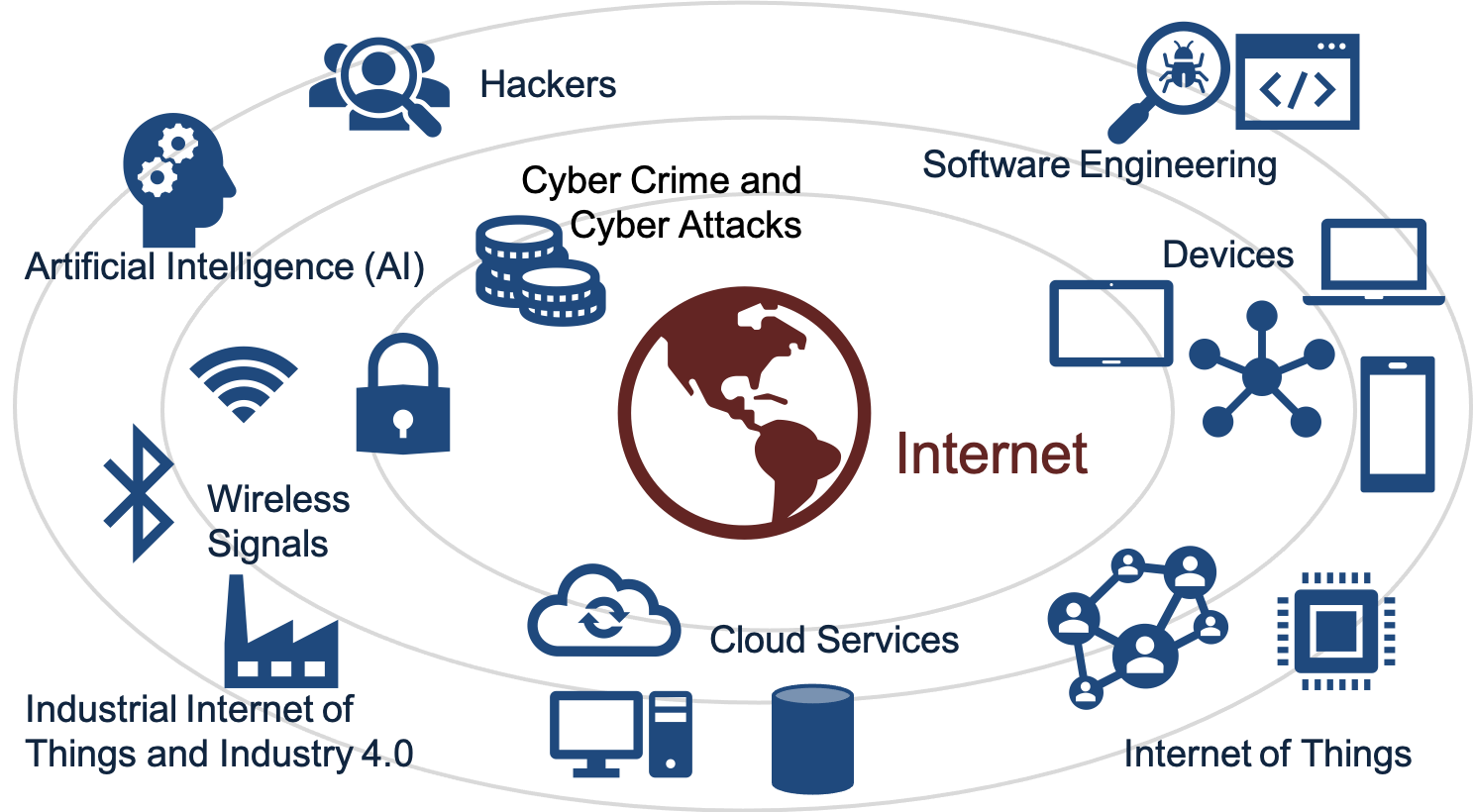
Cyber Security Overview (PDF)
Cyber Security (Textbook) (PDF)
Resources:
User Identity and Login (PDF)
SQL Injection (YouTube) + PowerPoint (PDF)
Here you find additional Cyber Security resources.
